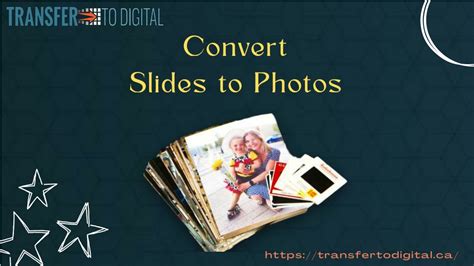Converting slides to digital pictures is a process that has become increasingly popular with the advancement of technology and the need to preserve memories from the past. Many individuals and organizations have a vast collection of slides that were taken years ago, and these slides contain valuable information, memories, and historical data. However, the traditional method of viewing slides using a slide projector has become outdated, and the slides themselves are prone to damage and deterioration. To overcome this challenge, converting slides to digital pictures has become a necessity.
Key Points
- Converting slides to digital pictures helps preserve memories and historical data
- Scanning and digitization are the primary methods used for conversion
- Digital images can be enhanced, shared, and stored for future generations
- High-quality scanning equipment and software are essential for optimal results
- Professional services are available for large-scale slide conversion projects
Naturally Worded Primary Topic Section with Semantic Relevance

The process of converting slides to digital pictures involves several steps, including scanning, digitization, and editing. The first step is to scan the slides using a high-quality scanner, which can capture the images at a high resolution. The scanning process can be done manually or using an automated scanner, depending on the number of slides and the desired level of quality. Once the slides are scanned, the images are digitized and saved in a digital format, such as JPEG or TIFF.
Specific Subtopic with Natural Language Phrasing
There are several methods used for scanning slides, including flatbed scanning, film scanning, and drum scanning. Flatbed scanning is the most common method, which involves placing the slide on a flatbed scanner and scanning the image. Film scanning, on the other hand, involves scanning the slide using a dedicated film scanner, which can capture the image at a higher resolution. Drum scanning is a high-end method that involves scanning the slide using a rotating drum, which can capture the image at an extremely high resolution.
| Scanning Method | Resolution | Cost |
|---|---|---|
| Flatbed Scanning | 1200 dpi | $100-$300 |
| Film Scanning | 4000 dpi | $500-$1000 |
| Drum Scanning | 8000 dpi | $2000-$5000 |

Advanced Scanning Techniques and Software

In addition to the scanning method, the software used for scanning and editing can also affect the quality of the digital images. There are several software programs available that can be used for scanning and editing, including Adobe Photoshop, Lightroom, and specialized slide scanning software. These programs can help enhance the images, remove dust and scratches, and adjust the color and contrast. Some software programs also offer advanced features, such as automatic image correction, noise reduction, and batch processing.
Technical Specifications and Equipment
To achieve high-quality digital images, it’s essential to use high-quality scanning equipment and software. A good quality scanner should have a high resolution, such as 4000 dpi or higher, and be specifically designed for slide scanning. The software used for scanning and editing should also be capable of handling high-resolution images and offer advanced features for image enhancement and correction. Additionally, a good quality monitor and printer can help ensure that the digital images are displayed and printed accurately.
What is the best method for scanning slides?
+The best method for scanning slides depends on the number of slides, the desired level of quality, and the equipment available. Flatbed scanning is a common method, but film scanning and drum scanning can offer higher quality images.
How can I enhance the quality of my digital images?
+There are several ways to enhance the quality of digital images, including adjusting the color and contrast, removing dust and scratches, and using noise reduction software. Additionally, using a high-quality scanner and software can help ensure that the images are captured and edited accurately.
Can I convert my slides to digital pictures myself, or do I need to hire a professional?
+You can convert your slides to digital pictures yourself using a scanner and software, but hiring a professional can offer several benefits, including high-quality images, efficient processing, and expert knowledge. Additionally, professional services can handle large-scale projects and offer specialized equipment and software.
Converting slides to digital pictures is a process that requires careful consideration of the scanning method, software, and equipment used. By using high-quality scanning equipment and software, and following best practices for scanning and editing, you can create high-quality digital images that preserve your memories and historical data for years to come. Whether you choose to convert your slides yourself or hire a professional, the end result will be a collection of digital images that can be shared, stored, and enjoyed for generations to come.



